The Dyes of Death
By Lidia Plaza
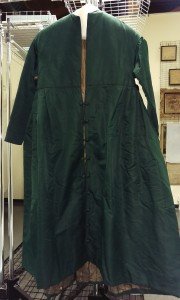 1978.107.7a Pelisse (1839). Gift of Miss Doris L. Kramer through Mrs. Charles Klopper. This emerald green pelisse may have been dyed with Scheele's green.
1978.107.7a Pelisse (1839). Gift of Miss Doris L. Kramer through Mrs. Charles Klopper. This emerald green pelisse may have been dyed with Scheele's green. As we’ve been going through the collection, we've found a number of striking green ladies’ dresses from the 19th century that grabbed our fascination. Green was a very popular color in the 19th century, made possible by advancements in dyeing techniques. In 1778, the Swedish chemist Karl Scheele discovered how to make “Scheele’s green,” a pigment made with copper arsenite. The pigment became a sensational success and was used enthusiastically during the period, most commonly in wallpapers, paints, but it was also used to color textiles. Textile manufacturers were particularly enthralled with the new pigment, as green was a notoriously difficult color to produce. Earlier green dyes were typically achieved by overlaying blue and yellow. Expert dyers could obtain brilliant results, but the color would usually fade over time. Scheele’s green however produced a brilliant result with a single, seemingly colorfast, pigment. It is because of this that Scheele’s green became a predominate feature in early Victorian England.
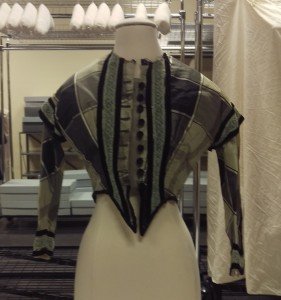 1929.13.1 Dress worn by Harriet Cohen to the wedding of her son, Mendes Cohen (October 18, 1865). The Estate of Miss Bertha Cohen. Copper arsenite might have been used for the greens in this plaid bodice.
1929.13.1 Dress worn by Harriet Cohen to the wedding of her son, Mendes Cohen (October 18, 1865). The Estate of Miss Bertha Cohen. Copper arsenite might have been used for the greens in this plaid bodice.
Unfortunately, the miracle dye contained dangerous quantities of the poison arsenic (III) oxide (As2O3), commonly referred to as simply arsenic. Scheele himself was aware of the health risks associated with arsenic, but continued to produce the popular green anyway. Reports of arsenic-related illness circulated throughout the 19th century, with Scheele green wallpapers often to blame. Victims reported rash, vomiting, abdominal cramps, and headaches, which led to sever illness and in some cases, death.
Scheele's green was not the only dangerous dye in the 19th century. Arsenic was also used in some blue, yellow, and magenta dyes. Furthermore, arsenic was not the only hazardous element used in 19th century fabrics. The artificial dye industry flourished upon the discovery of tar-coal dyes in the 1840's and 1850's. Aniline purple or mauve was perhaps the most famous of this class of early artificial dyes. The popular dye was joked to have given the population “Mauve Measles,” but synthetic dyes were known to leach out fabrics if not washed carefully and cause mild to sever skin irritation. Nevertheless, the synthetic colors remained popular in Victorian society.
Testing the Textiles
As fascinating as “Mauve Measles” are, my main interest is jewel-tone green colors. In the past weeks, I have been researching the chemistry and history of green dyes in hopes of eventually testing the garments for arsenic.
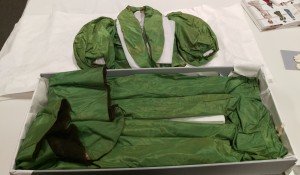 1948.40.8a,b Dress (1890-93). Gift of the Estate of Marion Fisher. A dress that may have been dyed with arsenic-containing compounds.
1948.40.8a,b Dress (1890-93). Gift of the Estate of Marion Fisher. A dress that may have been dyed with arsenic-containing compounds.
The first gown that caught my eye was donated to the Maryland Historical Society in 1948 through the estate of Miss Marion Fisher. The provenance for the dress dates it at 1890-93 and the richness of the green is typical of a dress dyed with copper arsenite. Though Scheele’s green had come under harsh criticism by the 1890's, the dress still struck me as a good candidate for an arsenic-containing dye.
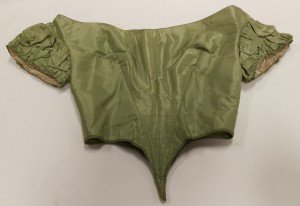 1957.16.1b, Bodice (ca. 1855). Gift from the Pratt Library. The green bodice worn by Mrs. Enoch Pratt which may contain arsenic
1957.16.1b, Bodice (ca. 1855). Gift from the Pratt Library. The green bodice worn by Mrs. Enoch Pratt which may contain arsenic Another dress that may test positive for arsenic is a gown that was donated by the Pratt Library and was worn by Mrs. Enoch Pratt (neé Maria Louisa Hyde) . The gown was on display for a number of years in 1970’s and light damage has faded the the jacket, but the interior bodice maintains the potent green color. It is a good example of the iconic Victorian green from the 1850's, and is another possible candidate for copper arsenite.
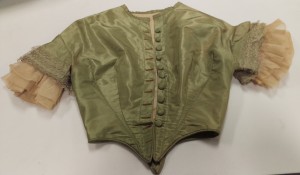 1957.16.1a Jacket (ca. 1855) Gift from the Pratt Library. Jacket worn by Mrs. Enoch Pratt. Light damage has faded the green hue.
1957.16.1a Jacket (ca. 1855) Gift from the Pratt Library. Jacket worn by Mrs. Enoch Pratt. Light damage has faded the green hue.
References:
- David, Alison Matthews & Semmelhack, Elizabeth. (2014). Fashion Victims: Pleasures & Perils of Dress in the 19th Century. Beta Shoe Museum.
- Finlay, Victoria. (2004). Color. New York: Random House Trade Paperbacks.
- Haslam, Jessica Charlotte. (2013). “Deadly Decor: A Short History of Arsenic Poisoning in the Nineteenth Century,” Res Medica, Volume 21(1), pp.76-81.
- Haxton, Katherine. (2011). “All About Arsenic,” Nature Chemistry 3, 744.
- Hornix, Willem J. (Mar., 1992). “From Process to Plant: Innovation in the Early Artificial Dye Industry,” The British Journal for the History of Science, Vol. 25, No. 1, Organic Chemistry and High Technology, 1850-1950, pp. 65-90.
- Meharg, Andy. (12 June 2003). “Science in Culture,” Nature 423, 688.

